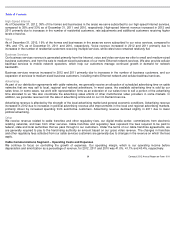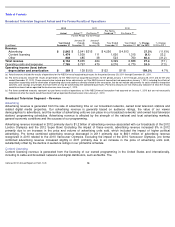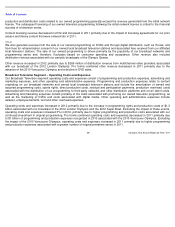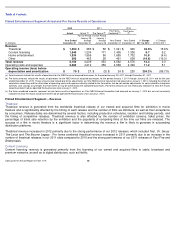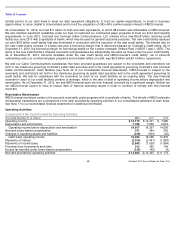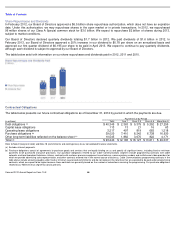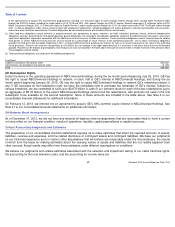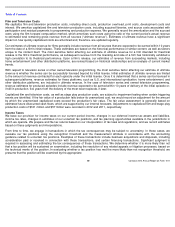Comcast 2012 Annual Report Download - page 62
Download and view the complete annual report
Please find page 62 of the 2012 Comcast annual report below. You can navigate through the pages in the report by either clicking on the pages listed below, or by using the keyword search tool below to find specific information within the annual report.
Table of Contents
Content licensing revenue increased in 2012 primarily due to a higher volume of our owned and acquired films made available
to
licensees in 2012, as well as an increase in licensing of our content to digital distributors. Pro forma combined content licensing
revenue increased in 2011 primarily due to the timing of when our owned and acquired films were made available to licensees.
Home Entertainment
Home entertainment revenue is generated from the sale of our owned and acquired films on DVDs to retail stores, rental kiosks and
subscription by mail services, and through digital distributors, such as iTunes. Home entertainment revenue is significantly affected
by the timing and number of our releases and their acceptance by consumers. Release dates are determined by several factors,
including the timing of the exhibition of a film in movie theaters, holiday periods and the timing of competitive releases.
Home entertainment revenue increased in 2012 primarily due to an increased number of, and improved performance of, our 2012
releases compared to our 2011 releases. Pro forma combined home entertainment revenue decreased in 2011 primarily due to the
overall decline in the DVD market and fewer titles released in 2011.
The DVD market continues to experience declines due to the impact of weak economic conditions, the maturation of the standard-
definition DVD format, piracy, and increasing shifts in consumers toward subscription rental services, discount rental kiosks and
digital distributors, which generate less revenue per transaction than DVD sales.
Other
We also generate revenue from producing and licensing live stage plays and distributing filmed entertainment produced by third
parties. Other revenue decreased in 2012 and pro forma combined other revenue decreased in 2011 primarily due to lower revenue
generated from our stage plays as a result of fewer productions.
Filmed Entertainment Segment – Operating Costs and Expenses
Our Filmed Entertainment segment operating costs and expenses consist primarily of production expenses, advertising and
marketing expenses, and other operating and administrative expenses. Production expenses include the amortization of capitalized
film production and acquisition costs, residual and participation payments, and distribution expenses. Residual payments represent
amounts payable to certain of our employees, including freelance and temporary employees, who are represented by labor unions or
guilds and are based on post-
theatrical revenue. Participation payments are primarily based on film performance and represent
contingent consideration payable to creative talent and other parties involved in the production of a film. Advertising and marketing
expenses consist primarily of expenses associated with theatrical prints and advertising and the marketing of DVDs. Other operating
and administrative expenses include salaries, employee benefits, rent and other overhead expenses.
We incur significant marketing expenses before and throughout the release of a film in movie theaters. As a result, we typically incur
losses on a film prior to and during the film’
s exhibition in movie theaters and may not realize profits, if any, until the film generates
home entertainment and content licensing revenue. The costs of producing and marketing films have generally increased in recent
years and may continue to increase in the future, particularly if competition within the filmed entertainment industry continues to
intensify.
Operating costs and expenses increased in 2012 primarily due to higher amortization of film costs associated with the higher cost of
our 2012 slate, as well as an increase in marketing costs associated with our 2012 theatrical and DVD releases. These costs were
partially offset by lower costs generated from our stage plays as a result of fewer productions. Pro forma combined operating costs
and expenses increased in 2011 primarily due to an increase in marketing expenses associated with promoting our 2011 theatrical
releases.
59
Comcast 2012 Annual Report on Form 10
-
K




